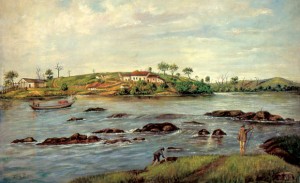
Paulista Museum/USP
São Paulo hinterland in the 19th century portrayed in the painting Pirapora do Curuçá (nowadays Tietê), 1826, by Zilda PereiraPaulista Museum/USPThe hiring of scientists by the State to conduct research studies on nature and improve technologies is far from being a recent initiative in Brazil. In the late 18th century, the Portuguese Court expressly ordered the generals (governors) in the Brazilian provinces to hire naturalists whose task was to map the territory, prospect for minerals and develop and disseminate more efficient agricultural techniques. The ultimate objective was to generate money and help balance the Portuguese Kingdom’s shaky accounts.
The order to seek men of science able to conduct research on Brazil’s natural resources came from Dom Rodrigo de Sousa Coutinho, when he took on the post of Secretary of the Navy and Overseas Domains in 1796. At that time, Coutinho drew up a new policy for the administration of Portugal’s colonial empire. Coutinho felt it was urgent to identify the economic usefulness of the native species and investigate the real mineral potential of the lands overseas. The governors of each province were ordered to supervise the work and report progress on course to the Court.
Naturalists were hired in the states of Minas Gerais, Pernambuco, Bahia and Ceará. In São Paulo, governor Antônio Manuel de Melo Castro e Mendonça retained the services of João Manso Pereira, a self-educated grammar professor and chemist who spoke Greek, Hebrew and French. Manso Pereira was involved in a wide range of activities. “Manso is a noteworthy example of self-education. Although he had never traveled out of Brazil, he always made a point of being updated on the scientific news abroad,” says historian Alex Gonçalves Varela, a researcher from the Astronomy and Astronomy Sciences Museum/Mast, who wrote the book Atividades científicas na “Bela e Bárbara” capitania de São Paulo (1796-1823) (published by Editora Annablume, 2009). The chemist was also an inventor and published a number of scientific papers, on topics ranging from the reform of stills and transportation of alcoholic beverages to the construction of nitrate beds to produce potassium nitrate. However, Manso’s project to open an ironworks factory was unsuccessful. “This was when his lack of a formal education became a barrier.”
In 1803, Pereira Manso was substituted by Martim Francisco Ribeiro de Andrada e Silva, who had been appointed by governor Antônio José de Franca e Horta. The brother of José Bonifácio – who would play an important role in Brazil’s quest for independence – Martim was different from João Manso. He had a solid academic background, had traveled through Europe and had studied at the University of Coimbra. A translator of scientific works, Martim had traveled extensively through the state of São Paulo and disseminated mineral science at that time. “He followed a set of scientific practices that existed at the time; that is, description, identification and classification of minerals at the sites where they were found,” says Varela. Years later, Martim and Bonifácio explored São Paulo’s hinterland together (see Pesquisa FAPESP issue 96).
João Manso, Martim and Bonifácio had vast knowledge and a strong connection with the politics of those times in common. In 1822, Martim was appointed Minister of Finances by his brother and became a member of the so-called “cabinet of the Andradas.” According to Varela, the scientific work of the three naturalists was extremely important for the Portuguese government to become acquainted in detail with the captaincy of São Paulo and its natural resources.
“Brazilian science and technique are not as recent as had been stated until the mid 1980’s and had begun long before biomedical institutes were implemented in the late 19th and early 20th centuries,” says the historian. “There are many examples of erudite men who investigated nature and worked with utilitarian-like science to produce knowledge in Colonial Brazil.” And finally, some interesting information: the words “naturalist” and “natural philosopher” are still used by historians to refer to men of science of those times because the word “scientist” was only coined in 1833, when it was used for the first time by polymath William Whewell, who coined the word to refer to the people attending a meeting of the British Association for the Advancement of Science.
Republish
